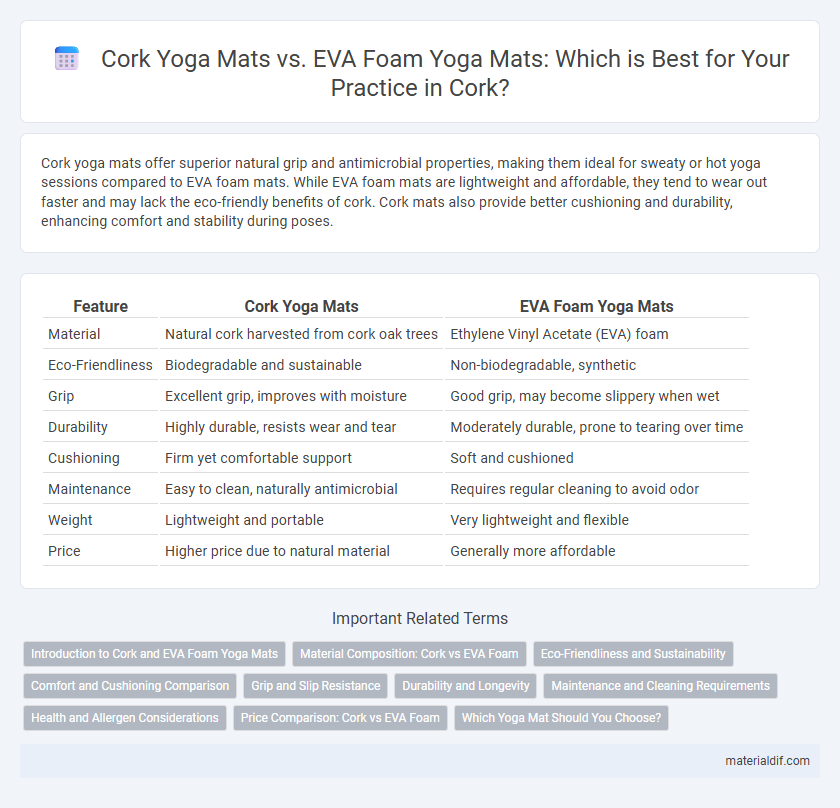Cork yoga mats offer superior natural grip and antimicrobial properties, making them ideal for sweaty or hot yoga sessions compared to EVA foam mats. While EVA foam mats are lightweight and affordable, they tend to wear out faster and may lack the eco-friendly benefits of cork. Cork mats also provide better cushioning and durability, enhancing comfort and stability during poses.
Table of Comparison
| Feature | Cork Yoga Mats | EVA Foam Yoga Mats |
|---|---|---|
| Material | Natural cork harvested from cork oak trees | Ethylene Vinyl Acetate (EVA) foam |
| Eco-Friendliness | Biodegradable and sustainable | Non-biodegradable, synthetic |
| Grip | Excellent grip, improves with moisture | Good grip, may become slippery when wet |
| Durability | Highly durable, resists wear and tear | Moderately durable, prone to tearing over time |
| Cushioning | Firm yet comfortable support | Soft and cushioned |
| Maintenance | Easy to clean, naturally antimicrobial | Requires regular cleaning to avoid odor |
| Weight | Lightweight and portable | Very lightweight and flexible |
| Price | Higher price due to natural material | Generally more affordable |
Introduction to Cork and EVA Foam Yoga Mats
Cork yoga mats, made from natural cork harvested from cork oak trees, offer a sustainable and eco-friendly surface known for its antimicrobial properties and excellent grip, especially when wet. EVA foam yoga mats, manufactured from ethylene-vinyl acetate, provide lightweight cushioning, shock absorption, and affordability, making them popular among beginners and gym users. Cork mats excel in durability and texture, while EVA foam mats prioritize softness and portability.
Material Composition: Cork vs EVA Foam
Cork yoga mats are made from natural bark harvested from cork oak trees, offering a renewable, biodegradable material rich in antimicrobial properties, making them ideal for eco-conscious practitioners. EVA foam mats consist of ethylene-vinyl acetate, a synthetic polymer blend known for its lightweight cushioning, durability, and moisture resistance but lack the natural biodegradability and unique texture of cork. The distinct composition influences grip, comfort, and environmental impact, with cork mats providing superior traction when wet and EVA foam mats excelling in softness and shock absorption.
Eco-Friendliness and Sustainability
Cork yoga mats offer superior eco-friendliness due to their natural, biodegradable material harvested from renewable cork oak trees without harming the bark, making them a sustainable choice compared to EVA foam mats derived from non-biodegradable petroleum-based plastics. Cork mats naturally resist mold and bacteria, reducing the need for harmful chemical cleaners often required for EVA foam, which contributes to a lower environmental impact throughout their lifecycle. Choosing cork mats supports sustainable forestry practices and reduces reliance on synthetic, fossil fuel-derived materials prevalent in EVA foam production.
Comfort and Cushioning Comparison
Cork yoga mats provide a firm yet comfortable surface with natural shock absorption, ideal for stability-focused practices and superior grip even when wet. EVA foam yoga mats excel in cushioning, offering plush softness that reduces joint strain, making them suitable for beginners or those with sensitive knees. The choice between cork and EVA foam hinges on the balance between durability, grip, and the level of comfort required for specific yoga styles.
Grip and Slip Resistance
Cork yoga mats offer superior grip and slip resistance due to their natural texture, which becomes even more effective with moisture from sweat, providing a stable practice surface. EVA foam yoga mats provide decent cushioning but often lack the same level of traction, especially when wet, leading to potential slipping during intense sessions. The eco-friendly properties of cork also enhance durability and maintain grip quality over time compared to synthetic EVA foam materials.
Durability and Longevity
Cork yoga mats offer superior durability due to their natural resistance to wear, moisture, and bacteria, making them an eco-friendly option that maintains integrity over time. In contrast, EVA foam yoga mats, while lightweight and affordable, tend to compress and degrade faster with frequent use, especially in high-traffic yoga routines. Cork's dense cellular structure ensures longer longevity by resisting cracking and surface damage, positioning it as a preferred choice for practitioners seeking lasting performance.
Maintenance and Cleaning Requirements
Cork yoga mats require minimal maintenance due to their natural antimicrobial properties, resisting odors and bacteria buildup without harsh cleaning agents. In contrast, EVA foam yoga mats need regular cleaning with mild soap and water to prevent sweat and grime accumulation, as their porous surface can harbor bacteria. Cork mats dry faster and are less prone to wear from repeated washing, making them a sustainable, low-maintenance option for everyday practice.
Health and Allergen Considerations
Cork yoga mats offer a natural, hypoallergenic surface resistant to mold and bacteria, making them ideal for individuals with allergies or sensitive skin. EVA foam yoga mats, while lightweight and cushioning, may emit volatile organic compounds (VOCs) that can trigger respiratory irritations in some users. Choosing cork mats supports a healthier practice environment by minimizing exposure to synthetic chemicals and allergens often found in foam materials.
Price Comparison: Cork vs EVA Foam
Cork yoga mats typically range from $40 to $80, offering eco-friendly durability and natural antimicrobial properties, while EVA foam mats are generally priced between $10 and $30, making them more budget-friendly but less sustainable. Cork mats provide a superior grip and longevity, justifying their higher cost for practitioners focused on quality and environmental impact. EVA foam mats suit beginners or casual users seeking affordable options without the premium characteristics of cork.
Which Yoga Mat Should You Choose?
Cork yoga mats offer natural antimicrobial properties, excellent grip, and eco-friendliness, making them ideal for practitioners in Cork seeking sustainable options. EVA foam yoga mats provide superior cushioning and lightweight durability, suitable for high-impact or travel-friendly workouts. Choosing between cork and EVA foam depends on preferences for sustainability, comfort, and mat performance during various yoga styles.
Cork Yoga Mats vs EVA Foam Yoga Mats Infographic

 materialdif.com
materialdif.com